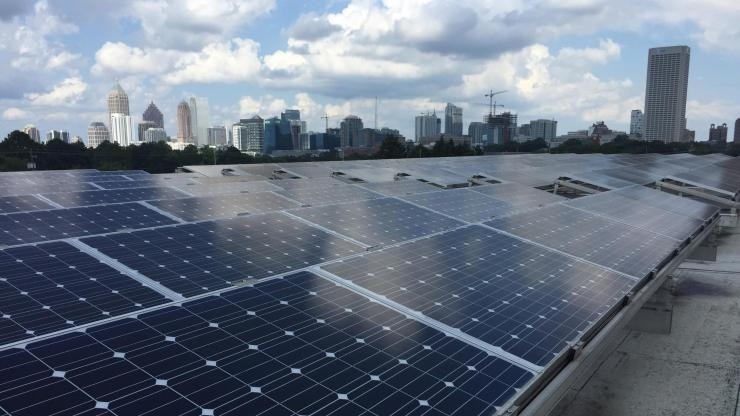Apr 5 2019
The past few years have witnessed a boom due to the dwindling cost of solar power, with an increasing number of photovoltaic panels emerging on backyard solar farms and rooftops across the globe.
 Rows of photovoltaic panels are shown atop a building on the Georgia Institute of Technology campus in Atlanta. (Image credit: John Toon)
Rows of photovoltaic panels are shown atop a building on the Georgia Institute of Technology campus in Atlanta. (Image credit: John Toon)
However, there is no clear definition of what will happen to all those solar panels when they come to the end of their useful life in a couple of decades. There were also concerns regarding electronic devices that have even shorter life spans.
Those queries form the central part of the latest study released by a research team at Georgia Institute of Technology, where investigators studied the effect of existing government policies to decrease the amount of electronics waste accumulating in landfills.
There is a lot of concern in sustainability circles that manufacturers are making things with shorter and shorter life spans, and products are perhaps even intentionally made to become obsolete to induce replacement purchases.
Beril Toktay, Professor, Scheller College of Business, Georgia Institute of Technology.
Reported in the journal Management Science on April 4th, 2019, the study concentrated on government policies used to motivate electronics manufacturers to give more thought into what happens to the product at the end of its life cycle. Such programs, known as extended producer responsibility, or EPR, laws, are already being used in certain states. They have two typical goals—to encourage manufacturers to develop products that can be recycled more easily or to increase the products’ durability for better life span. Conversely, those goals are usually at odds, reported the investigators.
What we have found is that sometimes when you design for recyclability, you give up on durability, and when durability is the goal, recyclability is sacrificed.
Beril Toktay, Professor, Scheller College of Business, Georgia Institute of Technology.
Theoretically, a product that lasts longer and easy to recycle would be the peak of environmentally responsible product design. In this context, automobiles having thicker metal frames that are more durable and also contain more recyclable materials were pointed out by the researchers. In such cases, EPR policies underscoring recyclability and durability operate hand in hand.
“Sometimes simple choices that product designers make, such as using glue or fasteners to put together a device, really impact recyclability at the end of life,” stated Natalie Huang, a former graduate student at Georgia Tech and currently an assistant professor at the University of Minnesota.
Yet, more often than not, no such synergy exists. With regards to photovoltaic panels, the team emphasized that since thin-film panels contain precious metals, they can be recycled much more cost-effectively when compared to other kinds of panels. In the meantime, crystalline silicon panels cannot be recycled cost-effectively, and since their components decompose much more gradually, they tend to have relatively longer life spans.
These kinds of trade-offs are common, and so from a policy-making perspective, there’s not a one-size-fits-all approach that will work. You really have to distinguish between different product categories to consider the recyclability and the durability implications and make sure that your policy isn’t conflicting with the objective.
Atalay Atasu, Professor, Scheller College of Business, Georgia Institute of Technology.
The team reported that in certain cases, EPR policies can, in fact, lead to increased amounts of greenhouse gas emissions if product designers create products that are made more long-lasting but less recyclable, or lead to increased generation of waste if products are made more recyclable but less durable.
Therefore, to help establish how individual products would be impacted by government policies, the investigators created a mathematical model to help predict the impact those policies would have on individual products predicated on their design characteristics and materials. Among the factors considered by the model are the product’s base production cost, the level of challenges in increasing durability and recyclability, the extent of interaction between durability and recyclability in the product design, and the product’s recycling characteristics.
Ultimately what we’re after is to find a way to do scenario analyses to determine what would be the best policy for different product categories. Fifteen to 20 years from now, a lot of panels are going to be coming off of roofs. Are they being designed with the end of life in mind and with consideration of what’s the best way to reduce the impact of producing those panels?
Beril Toktay, Professor, Scheller College of Business, Georgia Institute of Technology.